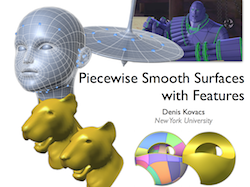
Abstract: The creation, manipulation and display of piecewise smooth surfaces has been a fundamental topic in computer graphics since its inception. The applications range from highest-quality surfaces for manufacturing in CAD, to believable animations of virtual creatures in Special Effects, to virtual worlds rendered in real-time in computer games.
Our focus is on improving the a) mathematical representation and b) automatic construction of such surfaces from finely sampled meshes in the presence of features. Features can be areas of higher geometric detail in an otherwise smooth area of the mesh, or sharp creases that contrast the overall smooth appearance of an object.
In the first part, we build on techniques that define piecewise smooth surfaces, to improve their quality in the presence of features. We present a crease technique suitable for real-time applications that helps increases the perceived visual detail of objects that are required to be very compactly represented and efficiently evaluated.
We then introduce a new subdivision scheme that allows the use of T-junctions for better local refinement. It thus reduces the need for extraordinary vertices, which can cause surface artifacts especially on animated objects.
In the second part, we consider the problem of how to build the control meshes of piecewise smooth surfaces, in a way that the resulting surface closely approximates an existing data set (such as a 3D range scan), particularly in the presence of features. To this end, we introduce a simple modification that can be applied to a wide range of parameterization techniques to obtain an anisotropic parameterization. We show that a resulting quadrangulation can indeed better approximate the original surface.
Finally, we present a quadrangulation scheme that turns a data set into a quad mesh with T-junctions, which we then use as a T-Spline control mesh to obtain a smooth surface.
